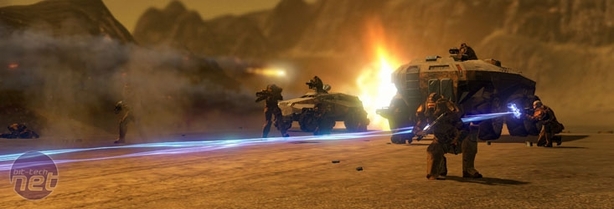Physics and Playability
Unlike most sandbox games though, we found ourselves rarely straying from the plotline of Red Faction: Guerilla in our time with the game. Most open-world games are built with a fair degree of redundancy, with players driving around town and getting into chases between missions – but that isn’t a factor for Red Faction.Most of the time you’re just having far too much fun to even think of going off-mission and a lot of that fun stems from the simple joy of being given increasingly large and complex buildings to destroy in the name of the cause. Explosions are the name of the game here – you can literally destroy anything that’s manmade.
You can crack individual tiles or supports in a building and, while there are times when it does all feel a little too lightweight and manufactured, the physics are still solid for the most part and you don’t ever want to turn your back on a building that’s had two walls knocked out. Even when there are buildings that still remain impossibly erect then it’s easily explained away by the fact that Mars has lower gravity than Earth.
The weak gravity isn’t just an excuse to cover the beta version we played though, thankfully. It also affects the physics of characters and vehicles, explaining why characters can effortlessly run around with sledgehammers in their hands and how the vehicles bounce across the mostly-rusty surface of the planet.
We say ‘mostly-rusty’ as, in order to give the landscape a little variation, Volition has varied the surface of the planet quite considerably. While you start off in the a-typical red dunes of the miners’ district, you’ll soon progress to greener climes. The primary purpose of the miners is to help terraform the planet, but the EDF has ensured that it’s the upper-classes who reap the benefits first. Expect to see plants and flora (not the butter) becoming more prevalent as you take the fight forward.
We found that our reactions to the physics system in Red Faction: Guerrilla happened in pretty predictable waves. We were first wowed by the ability to demolish things so fantastically and the tactics this opened up, such as crushing a marching line of soldiers with a carefully toppled streetlight.
Then we were disappointed and dismayed that the destruction didn’t extend into the scenery, leaving all your damage feeling impermanent and only half-realised. Finally, we forgot all about that thanks to the fun of driving through a barracks in a dumper truck, jumping out when we slowed under the debris, smashing through the rubble with a sledgehammer and then vaporising the final supporting beam with a nano-rifle.
We got a chance to have a go with an awful lot of weapons in our hands-on time with the game, but our favourite was definitely the nano-rifle. In a game where nearly every firearm is a re-purposed bit of mining machinery or otherwise explosive in some form, the nano-rifle’s energy beam stands out.
Quite simply, the nano-rifle uses a single concentrated beam of energy that uses nanites, we assume, to effervesce whatever it hits. While men will glitter away in a shower of neon pyrotechnics, buildings can be systematically dismantled, turning the game into a perverse version of Jenga. Because it can’t disintegrate an entire building, you find yourself taking out the supports and walls one by one – how many doors can you remove before the wall collapses?
Using the nano-rifle in this way can actually turn part of Red Faction: Guerrilla into an interesting ad-hoc multiplayer game if you want, but if it’s multiplayer you’re after then it’s by no means your only option.

MSI MPG Velox 100R Chassis Review
October 14 2021 | 15:04












Want to comment? Please log in.